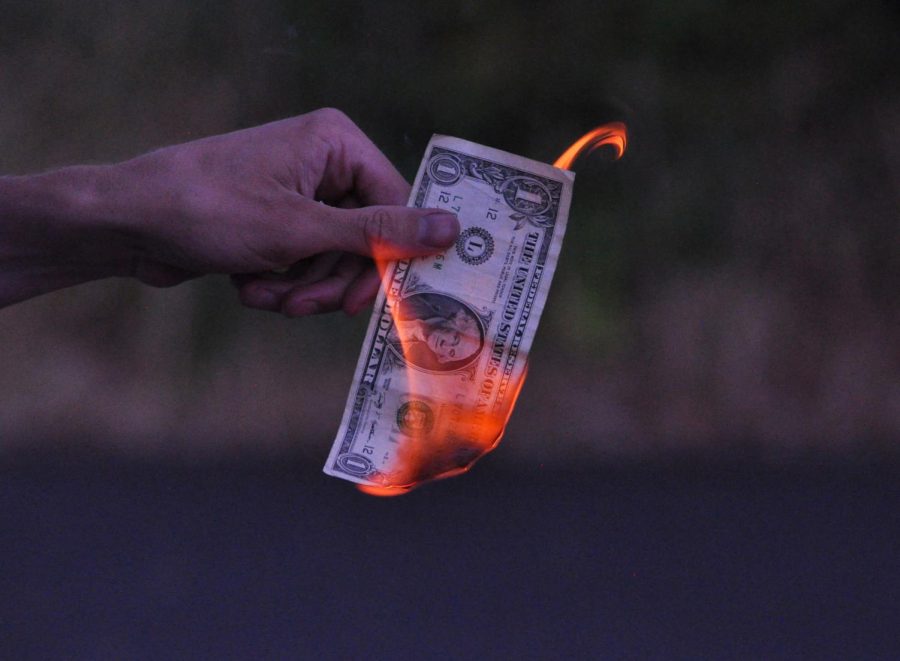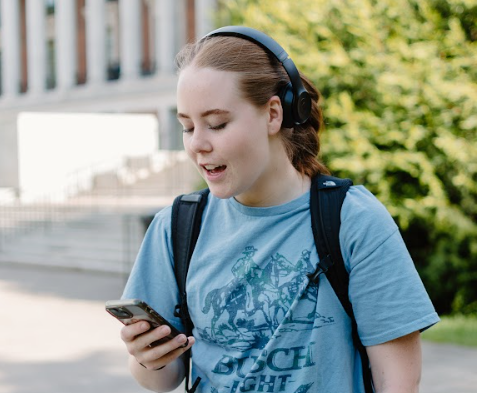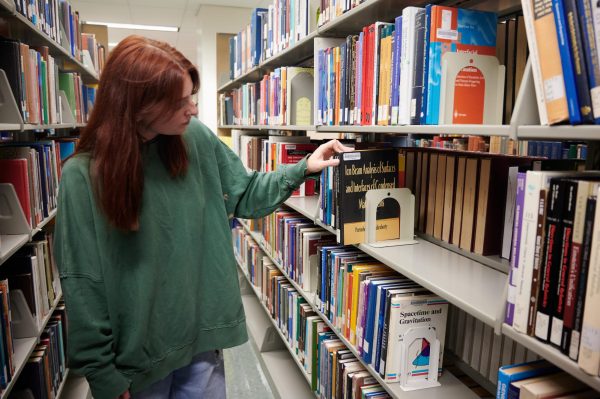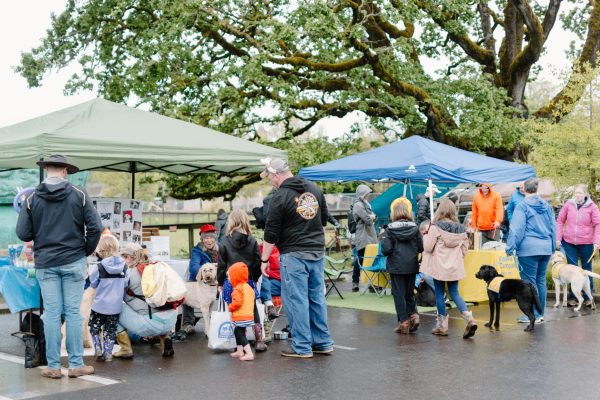Business professors explain inflation, give money-saving tips
By Hayden Lohr, OMN Photographer
Pictured here is a dollar bill on fire outside of Graceland Church, in Corvallis Ore. Spending money when inflation is so high can feel like a complete waste of money, or like setting it on fire, since $1 does not buy much these days.
August 4, 2022
As prices for goods and services increase nationwide, Corvallis residents may be noticing that their bank account is decreasing.
Oregon State University experts in economics and consumer culture broke down inflation trends in the U.S. and offered some practices for people to save money in this economy.
According to an article by MSNBC, inflation is at 9.1%, which is the highest it has been in 40 years. The same article reported that food costs have risen over 10.4% over the past 12 months.
Michelle Barnhart, associate professor of marketing in Oregon State University’s College of Business, has a research background in consumer culture.
“Over the last 30 years, inflation overall has been low, but rises in wages have been even lower,” Barnhart said. “In some categories, such as rent, college tuition and health care, prices have increased far more than incomes have.”
Barnhart believes saving money is difficult today because of the change in income. According to Barnhart, the average income 30 years ago bought more items than it does today.
“Interestingly, 50 years ago (1972) it was rapidly becoming more difficult to save than it is at the current historical moment. In 1972 both interest rates and inflation started to skyrocket, and unemployment increased as well,” Barnhart said.
According to Barnhart, in the past, the price of goods—especially big-ticket items for which people typically borrow money for—was increasing when lots of people were out of work.
“In contrast, today, we are seeing high inflation at the moment, but interest rates are still relatively low, 6.3% for a 30-year mortgage, and unemployment is very low, 3.6%, so while prices are increasing, at least people still have incomes,” Barnhart said.
Barnhart said another direct cause of inflation right now is the stimulus checks the U.S. government gave out to citizens during the beginning of the COVID-19 pandemic.
“The government stimulus during the pandemic was necessary to avoid economic catastrophe, and in a way, it worked too well. It put lots of money into the economy, which then had to go somewhere,” Barnhart said. “Consumers and firms have been spending it, increasing demand, and when demand goes up, prices go up. In addition, the war in Ukraine has pushed up the costs of both gas and food—two of the largest contributors to inflation.”
Another professor in the College of Business, Brian Gibbons, has a research background in information economics and teaches finance at OSU. Gibbons acknowledges the inflation in the 1970s and believes there is one major difference.
“One major difference between now and then is that safer forms of savings such as savings accounts or investing in government bonds haven’t looked very attractive,” Gibbons said. “When the interest on a savings account at the bank can be essentially rounded down to 0%, there is not much incentive for people to park their extra cash there.”
Gibbons acknowledged that lower- to middle- income brackets have less income to spare than people 30 to 50 years ago.
“This is where it pays to think like an economist. Economists like things with a high marginal benefit but low marginal cost—in other words, where you might get the biggest ‘bang for your buck,’” said Gibbons. “What I mean by that is identifying the big things we are spending money on, but getting little value from, and trying to save on those things before we start penny-pinching.”
One small way Gibbons has personally saved money is by switching his phone provider.
“I switched from a big wireless carrier where we paid hundreds per month to the more affordable Mint Mobile. I haven’t noticed a single difference in my quality of life because of the switch!” Gibbons said. “That’s a high marginal benefit for a low marginal cost and a one-time decision to switch like that is easy.”
Gibbons believes that one-time decisions may have more of an impact on saving money than daily decisions.
“It’s much more psychologically difficult to commit to cutting out that $3 to $5 coffee run per day to save money,” Gibbons said. “That’s a decision you are going to have to make over and over again, and likely fail at many times.”
Gibbons advice for the community is to make small decisions on big things that make a difference in your monthly budget.
As inflation takes its toll in America and people grapple with when to save money and where to spend it, Barnhart believes driving less can help. One of the biggest influences of high prices currently is gasoline, so Barnhart recommends community members drive less, carpool, ride the bus, walk or carpool.
“People can also reduce their energy costs by putting on lighter clothes and opening windows before resorting to turning on the air conditioning and turning off the air conditioning when they aren’t home,” Barnhart said. “In addition, buying more vegetables and less meat can cut your grocery bill, while also likely making your diet healthier.”
Barnhart said there is a simple solution for those facing difficulties navigating finances during this time.
“The answer is simple but difficult at the same time: Stop spending. Inflation is fueled by consumer spending. If a large portion of U.S. consumers stopped spending on anything that wasn’t a necessity, inflation would decrease,” Barnhart said.
Conversely, Gibbons weighs the matter of saving and spending during the current economic system in a different manner.
“There is a tradeoff here. If by ‘helping the economy’ we mean make sure the economy continues to grow and our neighbors have jobs, then we should continue to save less and spend more,” Gibbons said. “One person’s spending is another person’s income, so spending helps employment. But, if by ‘helping the economy’ we mean reducing prices, then we have to stop spending and save more.”
According to an article by the Washington Post, consumer confidence has decreased in the last three months. Consumer confidence is defined as consumers who are not confident about their financial prospects and tend to spend less money.
“For those with low to middle incomes, inflation in the costs of necessities like food, rent and gas is resulting in their using more of their income for these items—leaving less income available for savings,” Barnhart said. “Across all income levels, pent up desire for services that consumers haven’t used much since the start of the pandemic, like restaurants, entertainment and travel is leading to increased spending in those areas, which also leaves less income available to save.”
While some people who can afford to use goods and services which they have missed during the pandemic enjoy a minor dent in income, others may not be so privileged to be able to afford more than gas, rent and food this month.
“The psychology of money is hard. The method I teach my students and use myself is to either separate the direct deposit from your paycheck in several accounts,” Gibbons said.
Gibbons recommends an account for recurring expenses, future savings and an account for all the remaining money.
“This gets you 90-95% of the way to very healthy financial habits. Your bills are paid on time, you’re actually saving and investing money each month, and you don’t have to feel bad about spending the money you have left over on the other things you need or want,” Gibbons said.



















